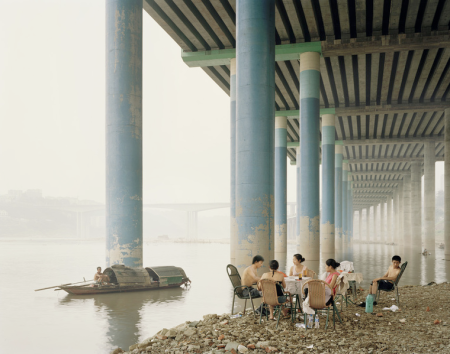This year’s Prix Pictet winner, photographer Nadav Kander will be joining Bronac Ferran, RCA IDE Senior Research Tutor and Yanki Lee Curator of the Constant Stream Exhibitions in conversation . Kander will discuss his works and reflect on his China experience. It will be an exceptional opportunity to hear one of the world’s leading photographers talk about his work.
6.45pm in Lecture Theatre 1Posts Tagged ‘Prix Pictet Winner’
Nadav Kander Discussion in London Feb 2nd
February 1, 2010Nadav Kander wins the 2009 Prix Pictet Prize
October 26, 2009The Prix Pictet is an annual search for photographs that communicate powerful messages of global environmental significance under a broad theme. This year that theme was “Earth”. Nadav Kander was nominated for his series of photos, Yangtze, The Long River Series, 2006-07, documenting the rapidly changing landscape and communities of China’s Yangtze River, from its mouth to source, and this past week he was awarded the prize at FIAC in Paris, which I just happened to be leaving from that day. Sadly I missed the announcement and events that evening, but was nonetheless thrilled at the news.
Kofi Annan, the Prix Pictet’s Honorary President while also esteemed Nobel Laureate and former Secretary General of the United Nations, awarded Kander the prize saying that, “The photographs were a compelling call for action to tackle climate change, the most serious humanitarian and environmental challenge facing the world today. Only weeks separate us from the decisive negotiations on climate change in Copenhagen. We are confronted with the vital need to prepare the political momentum necessary for a fair and effective post-Kyoto agreement. The images in front of us remind us of the fragility of our planet and the damage we have already done. When we see these photographs we cannot close our eyes and remain indifferent. Through our actions and voices, we must keep building the pressure to secure urgent action at Copenhagen and beyond.”
Kander is a British based photographer, one I’ve never had the chance to work with, but have wanted to a number of times. I remember doing an interview with a big time ad agency on the west coast, and Nadav Kander was the first photographer out of my mouth when I was asked which dream photographers I’d like to worth with but haven’t had the privilege of. Kander photographed the Yangtze River from mouth to source, or over 4000 miles of watery arteries running across China. According to his artist statement, he didn’t set out with any pre-conceived notions of the river or its inhabitants– which make up more than all of the people in the entire US– but instead let the landscape do the work for him, and guide the kind of pictures he took as a physical response to the environment. What struck me the most about these images is that despite the presence of people or industry, both creators of commotion and therefore sound, the pictures felt eerily quiet. The color palette of tans and browns that make up the river and smog feel as if sound would simply not exist in that landscape. This is reinforced in the way Kander effectively portrays the sheer size of the river– which directly relates to China’s ever increasing population growth and development—using people against the backdrop of overpasses, industry, and of course water. This makes the Chinese individual seem incredibly small as opposed to the gargantuan amount and speed of development currently taking place.
While these are just four examples from this body of work, I urge you not only to explore Kander’s work further by visiting this link to his personal website, but by also reading his moving and straight to the point artist statement which can be found here.






